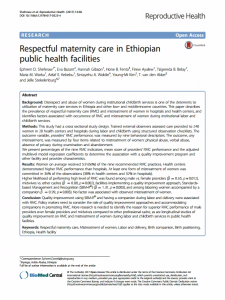
Background
Disrespect and abuse of women during institutional childbirth services is one of the deterrents to utilization of maternity care services in Ethiopia and other low- and middle-income countries. This paper describes the prevalence of respectful maternity care (RMC) and mistreatment of women in hospitals and health centers, and identifies factors associated with occurrence of RMC and mistreatment of women during institutional labor and childbirth services.
Methods
This study had a cross sectional study design. Trained external observers assessed care provided to 240 women in 28 health centers and hospitals during labor and childbirth using structured observation checklists. The outcome variable, providers’ RMC performance, was measured by nine behavioral descriptors. The outcome, any mistreatment, was measured by four items related to mistreatment of women: physical abuse, verbal abuse, absence of privacy during examination and abandonment.
We present percentages of the nine RMC indicators, mean score of providers’ RMC performance and the adjusted multilevel model regression coefficients to determine the association with a quality improvement program and other facility and provider characteristics.
Results
Women on average received 5.9 (66%) of the nine recommended RMC practices. Health centers demonstrated higher RMC performance than hospitals. At least one form of mistreatment of women was committed in 36% of the observations (38% in health centers and 32% in hospitals).
Higher likelihood of performing high level of RMC was found among male vs. female providers (βˆ=0.65β^=0.65, p = 0.012), midwives vs. other cadres (βˆ=0.88β^=0.88, p = 0.002), facilities implementing a quality improvement approach, Standards-based Management and Recognition (SBM-R©) (βˆ=1.31β^=1.31, p = 0.003), and among laboring women accompanied by a companion βˆ=0.99β^=0.99, p = 0.003). No factor was associated with observed mistreatment of women.
Conclusion
Quality improvement using SBM-R© and having a companion during labor and delivery were associated with RMC. Policy makers need to consider the role of quality improvement approaches and accommodating companions in promoting RMC. More research is needed to identify the reason for superior RMC performance of male providers over female providers and midwives compared to other professional cadre, as are longitudinal studies of quality improvement on RMC and mistreatment of women during labor and childbirth services in public health facilities.